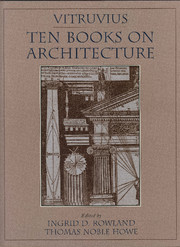Book contents
- Frontmatter
- Dedication
- Contents
- Acknowledgments
- List of Illustrations
- Translator's Preface
- Illustrator's Preface
- VITRUVIUS
- INTRODUCTION
- LIST OF MANUSCRIPTS SEEN
- THE TRANSLATION
- Book 1 First Principles and the Layout of Cities
- Book 2 Building Materials
- Book 3 Temples
- Book 4 Corinthian, Doric, and Tuscan Temples
- Book 5 Public Buildings
- Book 6 Private Buildings
- Book 7 Finishing
- Book 8 Water
- Book 9 Sundials and Clocks
- Book 10 Machines
- COMMENTARY
- Index
Book 4 - Corinthian, Doric, and Tuscan Temples
Published online by Cambridge University Press: 18 December 2014
- Frontmatter
- Dedication
- Contents
- Acknowledgments
- List of Illustrations
- Translator's Preface
- Illustrator's Preface
- VITRUVIUS
- INTRODUCTION
- LIST OF MANUSCRIPTS SEEN
- THE TRANSLATION
- Book 1 First Principles and the Layout of Cities
- Book 2 Building Materials
- Book 3 Temples
- Book 4 Corinthian, Doric, and Tuscan Temples
- Book 5 Public Buildings
- Book 6 Private Buildings
- Book 7 Finishing
- Book 8 Water
- Book 9 Sundials and Clocks
- Book 10 Machines
- COMMENTARY
- Index
Summary
PREFACE
1. When I had become aware, Imperator, that many writers had left behind them precepts and volumes of commentaries on architecture that were not set in proper order but taken up instead as if they were stray particles, I thought it would be a worthy and most useful contribution, first to set out the whole of such an excellent discipline in its full order and then in each volume to explain the particular qualities of each type of subject. And so, Caesar, in the first volume I told you about the duties of an architect and the subjects in which an architect ought to be well educated. In the second I discussed the supply of materials from which buildings are constructed. In the third volume, then, I offered instruction about the design of temples, and about the variety of their types, which species they have and how many, and what the distribution of the various components ought to be according to type. Of those three types whose proportions exhibit the most intricate modular systems, I taught the conventions of the Ionic. Now, in the present volume, I will speak about what have been set up as the Doric and Corinthian principles, and explain their distinctness and their special characteristics.
CHAPTER 1: THE DISCOVERY OF SYMMETRIES*
1. Except for the capitals, Corinthian columns have proportional systems like those of Ionic columns. The height of the Corinthian capital, however, makes these columns appear proportionately taller and more slender, because the height of the Ionic capital is one-third the diameter of the column, whereas that of the Corinthian measures the entire diameter of the shaft. Therefore, because the Corinthian capital is taller by two-thirds of a column diameter, its appearance, with this added height, is more slender (Figure 55). 2. The rest of the elements that are placed over the columns may be designed either according to Doric symmetries or Ionic conventions, because the Corinthian type itself has not had its own set rule for the cornices or for the rest of its ornamentation, so that the building may either be designed with the arrangement of triglyphs and mutules for the cornice and guttae along the epistyle, in the Doric fashion, or it may be designed according to Ionic rules* with a sculpted frieze, dentils, and moldings.
- Type
- Chapter
- Information
- Vitruvius: 'Ten Books on Architecture' , pp. 54 - 62Publisher: Cambridge University PressPrint publication year: 1999



